Watching the Ant Farm
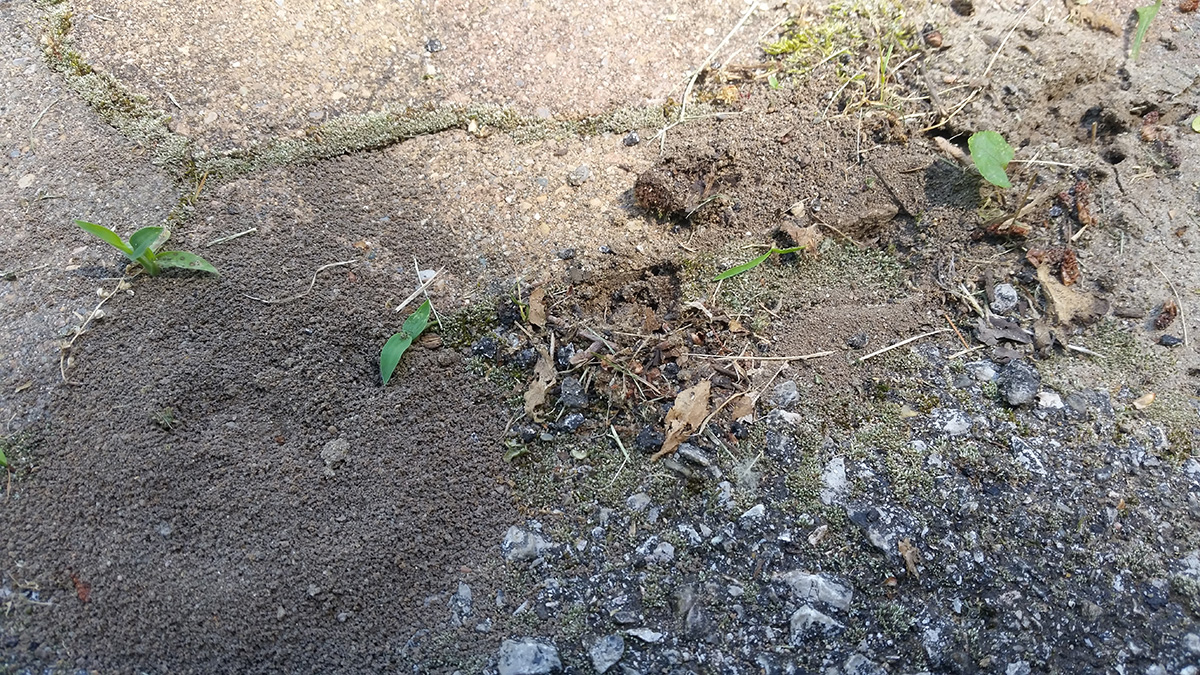
Just over eight months ago, I left full-time employment for my first ever career break. After working for nineteen years straight, I drifted off the grid into a world of uncertainty without a schedule and without income. I longed for this break. I dreamed of hitting pause on my life and jumping off the treadmill to catch my breath. The dream became reality on October 1, 2015, and now I stand on the outside watching the ant farm.
As I go through my day, I observe the swirl of the world around me. I watch the schedules of others: going to work, eating lunch on break, rushing the kids to school, going to meetings. I drive into Lexington for lunch with friends aware that I’m meeting them during their lunch breaks but calm in the knowledge that I don’t have to be anywhere. Though I’m doing freelance work as a web consultant, I have complete control of my schedule, working when it suits me best.
My mornings consist of adequate sleep, no alarms, and a healthy breakfast. My days hold as much or as little as I want to do whether it’s organizing a filing cabinet, writing a blog post, working on my other writing projects, configuring a website, or running errands. I eat better though my waistline doesn’t show it. I cook our meals as I dreamed I would when I worked late every night. I exercise more consistently. My levels of self-care increased exponentially.
In this time I breathe and look around me. I look inside myself. I am calmer now. Even standing in line at the grocery, my patience endures when I used to get frustrated. I am kinder now. Without the strains and pressures of my old life, I act in kindness, giving people the benefit of the doubt rather than judging them. My heart bursts with love, and I know this is all that matters in life. I am conscientious about how I spend my time and energy. I recognize what drains me and what lifts me. I concentrate my energy on what matters.
Even in the calmness, I fight back fears. I’m afraid of marking time for too long. I’m afraid I will not be able to relaunch into a career working for someone else. I’m afraid of wasting this opportunity. I fight the need to be productive at all times. I remind myself that in the quiet I find answers. I fight the tendency to dwell on the past and encourage myself to be content with the present. I fight my worries about the future where everything feels nebulous. I breathe and remind myself that I am right where I need to be right now.
The world goes on without me. I watch the activities of the ant farm and wonder if I can ever rejoin that world. I miss the distractions of the ant farm. I miss the sense of purpose. I know I’d be less apt to introspect and dwell. Still, I love standing on the outside. I cherish this time in my life and what it continues to give me. I was empty on October 1, 2015, drained of everything because I had given everything that I was to my work. Today I am fuller as I reconnect with everything I lost and find new gems that make my life richer in ways that money cannot purchase.
The Chicken Tikka Masala Quest

My love affair with Indian food started twenty years ago when one of my girlfriends introduced me to the cuisine at a restaurant in Chapel Hill, North Carolina. My friend recommended starting out with a mild chicken tikka masala. From the first bite, I was hooked. Through the years, I have tried all sorts of dishes, including kormas, vindaloos, and dosas. From delicate coconut curry fish dishes to the hottest gobi manchurian, I have traveled the range of Indian dishes from north to south and everywhere in between. My heat tolerance moved from mild to Indian hot, an accomplishment of which I am very proud. The tikka masala sauce continues to be my favorite, and I typically order paneer tikka masala as my go-to favorite.
You would probably not expect it, but Lexington, Kentucky happens to be blessed with nearly ten Indian restaurants. Several of them are quite good, and I have spent many happy moments dining in restaurants and retrieving carry out. When I moved outside of Lexington, I mourned losing the easy access to Indian food. Though I can (and frequently do) drive thirty-five minutes to pick up carry out or eat in a restaurant, I miss having Indian food at my fingertips, so I started on my quest to make Indian food in my own kitchen.
Every few months, I try a different chicken tikka masala recipe, hoping to find the one that most closely resembles the sauce I have eaten in so many restaurants. Tikka masala falls into the British Indian food category. According to legend, the dish came to be when an Indian chef in Britain needed to make a gravy for chicken tikka (which is a dry chicken dish). The sauce consisted of a tomato-based curry in cream sauce, and some stories say the chef used Campbell’s condensed tomato soup. That could be a marketing ploy, or maybe it’s true.
Most recipes taste too bright to me and don’t taste like the restaurant versions at all. By bright, I mean that the flavors are not deep enough. They don’t convey the warmth and lasting heat I expect from a tikka masala sauce. I attribute the brightness to too much yogurt, ginger, and lemon. I might be totally wrong on that score, but that is my theory. The other day I found a reddit thread where a poster provided some insight into how chicken tikka masala is made in Indian restaurants. Here’s the thread: https://m.reddit.com/r/IndianFood/comments/2kr4x3/tikka_masala_restaurant_style/. The big differences I see between what the poster described and how most recipes read is that you make two sauces (an onion/garlic/ginger gravy and a tomato-based sauce) and the onion mixture needs to sweat for at least an hour rather than undergo a quick saute. Both sauces need to be blended to make them smooth. They also need to be cooled to room temperature and then heated up again.
One dining experience sticks in my mind. I ordered paneer tikka masala Indian hot. The server brought out the mildest version of the dish I have ever had. In fact, it reminded me of tomato soup. My husband and I both wondered if that was one of the keys. Most recipes call for a combination of diced tomatoes, tomato paste, and/or tomato sauce. The result is usually incredibly acidic regardless of the amount of spices and cream added. The reddit thread mentioned using ketchup in the sauce. To make things simple I tried Campbell’s condensed tomato soup in my latest attempt.
The result of my latest chicken tikka masala challenge is close to restaurant quality but still different. I think I have an idea of what needs to happen next time, including additional cream, more chopped cilantro in the sauce itself, and fenugreek. In fact, fenugreek seems to be missing from most recipes although it is an essential Indian cuisine ingredient according to Serious Eats and other resources.
I thought I would share my latest creation. The process takes time, so I recommend giving it a whirl on a weekend afternoon. Once I get the recipe the way I want, I plan to make batches of the sauces and freeze them for later use. I tried to document measurements where I could though I did rough it on the ground pepper, cream, and cilantro.
Chicken Tikka Masala
Part One: Onion Gravy
1 large yellow onion
1 small yellow onion
⅛ cup chopped ginger
⅛ cup chopped garlic (I used the minced garlic in a jar)
1 tsp cumin
Vegetable oil
Rough chop the onion and toss into a sauce pan with vegetable oil (enough to cover the bottom and lightly coat the onions). Bring the onion to a sizzle on medium high and drop to simmer. Cover and allow the onion to sweat 45 minutes. Add ginger, garlic, and cumin and sweat an additional 15 minutes. Note: I think all ingredients could sweat together for a full hour, and I will try that next time. Remove from heat and run mixture through food processor or blender until smooth. Pour the mixture into a bowl and allow it to cool at room temperature.
Part Two: Tomato Base
1 family-size Campbell’s Condensed Tomato Soup can (23.2 oz.)
1 regular-size Campbell’s Condensed Tomato Soup can (10.75 oz.)
1 tsp onion salt
1 tsp turmeric
1 tsp red pepper flakes
1 tsp garlic powder
Ground pepper
Note: I used two different sizes of Campbell’s soup for fear of not having enough tomato base. Campbell’s does make an organic version of the condensed soup, and I’m sure other companies make similar products. I decided to go old-school and use the original version this time. You can take a more traditional path with diced tomatoes, tomato paste, and/or tomato sauce. From what I read in the Reddit thread, it is better to use sauces and pastes over actual diced tomatoes due to the water content.
Pour the cans of soup into a large skillet (that has a lid). Add onion salt, turmeric, red pepper flakes, garlic powder, and ground pepper. I just eye-balled the ground pepper. Bring to a boil and stir frequently for a few minutes. Reduce heat to simmer and cover with lid. Let it simmer for an hour or so, stirring occasionally. Then turn it off, remove from heat, and let it cool.
Part Three: Chicken Marinade
Harvestland chicken breast tenderloins
1 cup plain yogurt
1 tablespoon lemon juice
1 tablespoon garam masala
1 tsp sea salt
Note: I forgot to check the number of ounces on the Harvestland chicken breast tenderloins package, but there were 8 in the pack. You can use breasts or thighs, and it doesn’t have to be Harvestland. The recipe probably could have handled more chicken than I used, but I was on a sauce quest more than anything. Also, garam masala recipes vary widely. I used Frontier Garam Masala (Organic).
Cut the chicken into bite-size pieces. Coat the chicken in the garam masala and sea salt (you can use more sea salt than what I did). Combine the lemon juice and plain yogurt (I used a Greek-style yogurt), and coat the chicken pieces in the mixture. Chill the chicken in marinade in your refrigerator for at least 45 minutes but no more than 5 hours. I let the chicken marinade while the sauces cooled down.
Part Four: Final Preparation
1 chopped green pepper
Vegetable oil
2 tbsp Kerrygold butter
Heavy cream
Cilantro
Saute the chicken with one chopped green pepper and vegetable oil until cooked halfway. Heat up both the onion gravy and tomato base in separate pans to a boil.
Add chicken and green pepper to tomato base. Add onion gravy to tomato base. Bring to a boil and reduce heat. Simmer for a half hour.
Add 2 tablespoons of butter (I prefer Kerrygold). Make sure butter is fully melted into the sauce. Add heavy cream slowly and stir. You can use as much as you like. Add chopped cilantro to sauce. Again, use as much as you like.
Pour chicken tikka masala over basmati rice and serve with chopped cilantro on top.
 I ate the chicken tikka masala with store-bought naan and mango chutney, and of course, I had a glass of wine, and yes, I ate in front of my television. Don’t judge! 🙂
I ate the chicken tikka masala with store-bought naan and mango chutney, and of course, I had a glass of wine, and yes, I ate in front of my television. Don’t judge! 🙂This recipe is a work in progress. My next iteration will include fenugreek, more cilantro, and more cream. As I try new avenues, I will update the recipe and share it. If you have tips/suggestions, please feel free to add them in the comments.
A Scrub Pine for Christmas
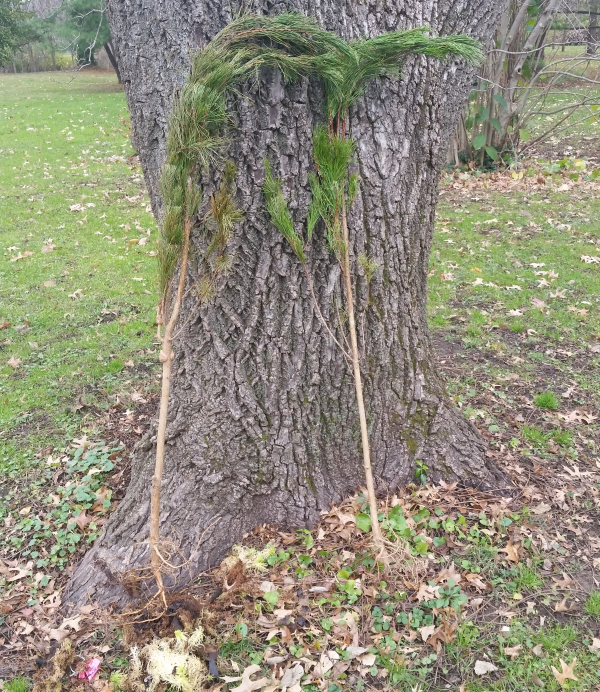
As I mentioned earlier this week, I like to bring a little vacation home with me. Though I was tempted to dig a scrub pine sapling on our October vacation in Florida, I refrained from breaking any laws. That didn’t mean that my scrub pine lust ended. Instead, I hopped online and tracked down a nursery that would ship a scrub pine to me.
In my Google searches, I learned that a scrub pine is also called a Virginia pine or New Jersey pine. In the south, they go by the informal name scrub pine, and the closer they are to the ocean, the more twisted and interesting they look. Here’s a picture of scrub pines by St. Joseph Bay in Florida.
 I love the lack of lower branches and gnarly bend of the scrub pines.
I love the lack of lower branches and gnarly bend of the scrub pines.Each year since we moved into our current (and final) home, we have purchased a living Christmas tree to display on our unheated sun porch and then plant in our yard as a reminder of that Christmas.
Christmas 2011
The first year we had a Baby Blue Eyes Spruce. This little tree is destined to remain small all our lives, but I guess that will make us feel young, right?
 This Baby Blue Eyes Spruce marks our first year in our home.
This Baby Blue Eyes Spruce marks our first year in our home.Christmas 2012
The second year we failed to find a decent tree, so we used an uprooted cedar sapling that didn’t survive. I hate it that we have that gap, but we had a lot going on at work that year, and we were unable to dedicate time to find a small but affordable living tree.
Christmas 2013
The third year we got a twisted long-needle White Pine at a local nursery. We found the tree among the regular trees, not the living Christmas trees, and it had a steep discount of 50% off. The tree is doing great in our side yard, and I love its imperfect structure.
 Our discount White Pine reminds us of 2013.
Our discount White Pine reminds us of 2013.Christmas 2014
The fourth year we located a super small Norway Spruce. This tree looked like it belonged in a mouse’s house, but it will be big before we know it.
 Our small Norway Spruce commemorates Christmas 2014.
Our small Norway Spruce commemorates Christmas 2014.Christmas 2015
This year I tracked down a Virginia Pine through a company called TN Tree Nursery in Altamont, Tennessee. It’s a wholesale nursery, but it delivers to residential customers as well. I was able to get a 4 to 5 foot scrub pine and get a second one free. The prices amazed me. So rather than wander from nursery to nursery hoping to find something that will work, I ordered my trees in early November, and they arrived the week before Thanksgiving.
 My trees for 2015 have a Dr. Seuss flair.
My trees for 2015 have a Dr. Seuss flair.The company digs the trees the day before delivery, packs the bare roots in a moisture gel with peat moss, and ships them in a box to your door. My trees arrived safely, and I promptly took them out of the box. I soaked them for two hours in a bucket of water as recommended in the instructions. I planted one of them in my front field, and I planted the other one, the taller one, in a container on my front walkway. I planned to move the container tree indoors the week prior to Christmas where it could sparkle with lights and ornaments, but I have changed my mind.


The tree on the left suffered from freeze damage while planted in a container. We planted the tree on the right the day after arrival, and it is doing very well.
Shortly after I planted my container tree and watered it each day for five days as recommended, we had a couple of days of heavy rain and then a cold snap. I did not notice that the rain compacted the soil in the container to the point where it exposed the upper roots. The needles turned brown, and only a few needles on the ends of the branches remained green with new growth. I think the tree suffered from freeze shock. I waited a few weeks to see if the tree would green up, and it did, but it’s not enough to be my living indoor tree for a week. I’ll figure out something else to do with that spot on my sun porch. Yesterday, I planted the container tree in the front yard where it can grow strong and prosper. I’ll be keeping an eye on both trees for the next several months.
 I’m filled with hope for our freeze damaged tree. The ends of the branches feature new growth.
I’m filled with hope for our freeze damaged tree. The ends of the branches feature new growth.So far, I’m very pleased with these trees from TN Tree Nursery. I know the conventional wisdom is that trees should travel north to south for best results, but Tennessee isn’t very far from Kentucky, so I’m optimistic these trees will do well. If all does go well, I’ll be buying more trees in the spring.
Just Keep Writing!

Though I completely dropped out of blog land for the month of November, I kept on writing. I participated in the NaNoWriMo (National Novel Writing Month) competition where the goal is to write 50,000 words in a month toward a novel. I wrote about it here near in the end of October. After a pretty rigorous writing schedule that ranged from 2,400 words per day to 3,112 words per day (I didn’t write on weekends, and I finished before Thanksgiving), I am proud to say I exited the competition a winner. Along the way, I learned a lot about myself as a writer and picked up some great tips.
You Don’t Need Inspiration All the Time
This might sound contrary to what you might have heard about writing, but you don’t need inspiration, at least not all the time. I used to believe that I had to feel inspired in order to write. The odd bit is that the act of writing itself is inspiring. For the competition, I made myself sit down at my computer at a specific time each day regardless of whether or not I felt like I had anything to write. More times than not, I warmed up each day and found myself buzzing along developing my story. On some days, I had no idea what would happen to my characters, but much like life itself, the story just moved in its own direction. I would start writing and make decisions about my characters on the fly.
Don’t Be Afraid to Write Total Crap
One of the things NaNoWriMo promotes is the acceptance that your first draft will be really bad. Once you accept that the initial draft is going to be terrible, your mind allows you to write freely. You shut off the internal editor and just write. Throughout the competition, I reminded myself that inaccuracies and the writing style itself would be shaped and corrected in the second and third drafts. The first draft involves assembling the skeleton. Everything else can be added and improved later.
50,000 Words is Not a Novel
Though the competition’s minimum accepted manuscript length is 50,000 words, that word count does not correlate with novel length, which is closer to 90,000 words. Knowing that I wasn’t writing the entire story in the month of November allowed me to develop my story at the pace that felt right to me. Beyond November, my goal is to write another 50,000 words by January 15th which would bring my word count to 100,000, and I’m well on the way at a total of 62,136 words as of today. Once I finish the first draft, it’s back to the drawing board as I rewrite the story as a second draft.
Writing Makes You a Writer
Before beginning my career break, I wanted to be a writer. I had fond memories of being a good writer in my younger years, but I also hadn’t done anything to foster my writing skills. The simple truth is that writing makes you a writer. Wanting to be a writer does not. The simple act of sitting down and putting words on paper, no matter how clever or how rough, makes you a writer. Until NaNoWriMo, I didn’t know I could make myself write so many words each day. Though I cannot say what I’ve written is particularly good, I can say that the bones of a good story are there, and continued writing will only make it better. I know now that I have the discipline to continue writing on a set schedule even if I work full-time doing something else.
Just Keep Writing
If I can boil the lessons of NaNoWriMo into one phrase, it would be “Just Keep Writing.” Turning off the internal editor and spilling the words onto the page is good for you. Having feelings of doubt? Just keep writing. Feeling uninspired? Just keep writing. Want to be a writer? Just keep writing. Want to write a novel? Just keep writing. Want to be a blogger? Just keep writing. Having problems with your characters? Just keep writing. Write your way through your problems. Write your way through your thoughts. Write your way through the bad writing so that you can find the good. Just keep writing! That’s what I intend to do. Whether my trashy little novel ever sees the light of day or not, at least I am making the effort, and I just keep writing.
Garden Thoughts on Vacation
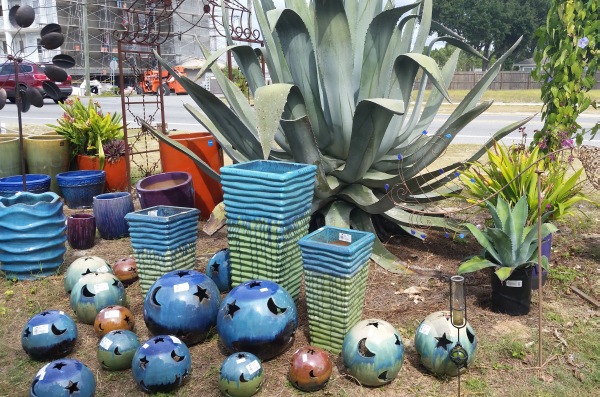
What do garden nerds do on vacation? They lust after gardens in other, warmer zones. They consider bringing back native plants. They purchase goods for the garden. On my last trip to Cape San Blas, Florida, I did all three.
Cape San Blas is my favorite retreat from the world on a little peninsula in the Florida Panhandle. The area goes by the name “The Forgotten Coast” and for good reason. If you want an abundance of restaurants, hotels, stores, put-put golf, amusement parks, and other places in your vacation destination, this area is not for you. If you want solitude, wide empty beaches, untouched woods, and a decent rental house, the Forgotten Coast area fits the bill.
During my time in this area, I lust after the crepe myrtles and hibiscus. I can grow both in my area (Zone 6), but they do not get as magnificent as they do in Florida. In fact, my crepe myrtles were all but obliterated by that jerk Jack Frost last winter. Our below zero temperatures destroyed the crepe myrtles and many other trees and shrubs. In fact, my crepe myrtles spent the summer as little sticks with tiny leaves sticking out of the ground. There were no luscious blooms for me, at least on the vast majority of my crepe myrtles.
 The Corinthian Bells windchimes hang on my screened-in porch.
The Corinthian Bells windchimes hang on my screened-in porch.My plant lust often leads to a desire to bring home native plants. For the past couple of years, I have had my eyes on the scrub pines. Maybe it’s just my observation, but Florida seems like it has more scrub pines than it can handle. We drove by an abandoned train track, and I saw tons of scrub pines, including very small saplings. I almost pulled over and snatched one for myself, but then I had images of myself getting hauled in for questioning about my pine tree theft. I’m not well-acquainted with the laws about native plants and easements, and I decided to avoid the drama.
Purchasing items for my yard is a safe fallback. In 2010, I traveled into Port St. Joe, the closest town with a full grocery store, and checked out the shops in area. I stopped at a place called Frost Pottery Garden near the edge of town. Somehow, I didn’t buy anything that day, most likely because I was still living in my half-duplex house with a small yard, but I fell in love with the place.
In 2013, I returned to Port St. Joe to visit the store only to discover it had moved to Mexico Beach, so my husband and I followed it. That time I purchased an awesome concrete turtle with shells embedded on it for my Mom. I am a little selfish because I knew she’d put it in the flower bed that spills into my yard. I also picked up a set of windchimes, and though the windchimes could be purchased anywhere, unlike the turtle, I loved that I bought them on vacation.
 This turtle sports shells all over its back.
This turtle sports shells all over its back.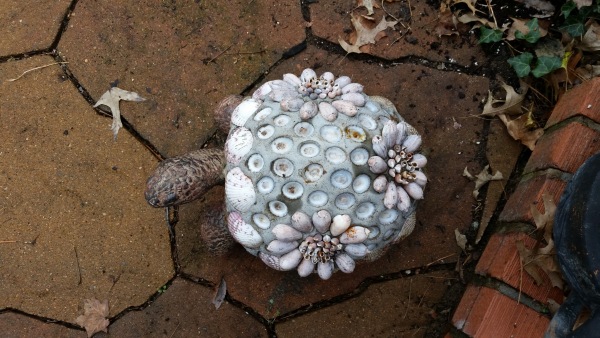 Here is an aerial view of the turtle.
Here is an aerial view of the turtle.Unfortunately, we were only in the area for three full days in 2014, so we weren’t able to make a Frost Pottery Garden trip, but this year, we made a special effort to get there. I had told my Mom about the place, and I offered to pick up items for her. Of course, in order for her to see what all they had, I took pictures and emailed them to her. I sat in the Adirondack chairs behind the store discussing photos with my Mom while my husband wandered around looking at the large variety of pots. I ended up selecting a large ceramic, celestial ball through which I can thread a solar light. We even got to enjoy it during vacation on our rental house’s coffee table after putting a candle in it.
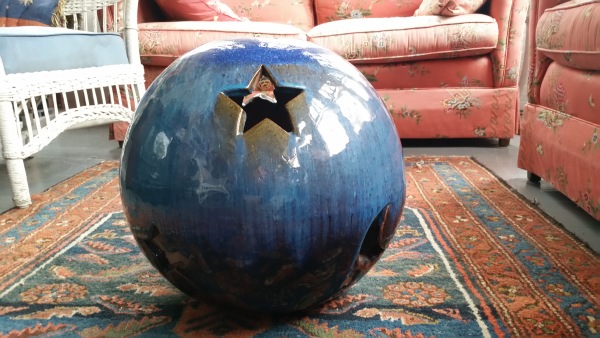 I’m planning to put a solar light in the celestial ball when I move it to the fish pond area in the spring.
I’m planning to put a solar light in the celestial ball when I move it to the fish pond area in the spring.Though Kentucky has a lot to offer, a vast selection of pottery is hard to find. My thought is that outdoor pottery lasts longer in Florida, so naturally they have a far better selection. Still, Frost Pottery Garden strikes me as a very special place, and I will keep going there year after year. It’s my own way of bringing a little Florida back with me without breaking any laws about digging native plants!
 This photo from Frost Pottery Garden does not even begin to do this place justice. The variety of pottery available is staggering.
This photo from Frost Pottery Garden does not even begin to do this place justice. The variety of pottery available is staggering.